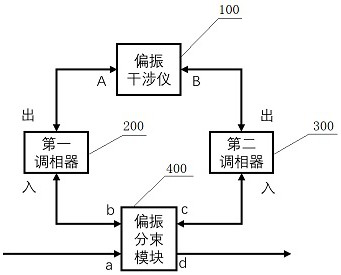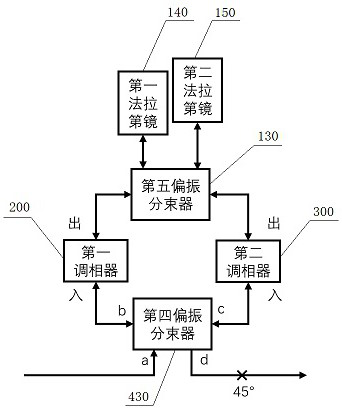Quantum key distribution coding device
A technology of quantum key distribution and encoding devices, which is applied in the field of quantum key distribution encoding devices, can solve problems such as inability to implement protocols or encoding methods, incompatibility with other protocols or encoding methods, increase system complexity and cost, and achieve Improve stability and practicability, increase security code rate, and stabilize encoding effect
- Summary
- Abstract
- Description
- Claims
- Application Information
AI Technical Summary
Problems solved by technology
Method used
Image
Examples
Embodiment 1
[0055] The structure of the encoding device is: the polarization beam splitting module 400 includes a circulator 420 and a first polarization beam splitter 410, the port a of the circulator 420 is used as the port a of the polarization beam splitting module 400; the circulator Port b of 420 is connected to port a of the first polarization beam splitter 410; port b and port c of the first polarization beam splitter 410 are respectively used as port b and port c of the polarization beam splitting module 400; the circulator The output polarization-maintaining fiber of port c of 420 is fused at 45° to serve as port d of the polarization splitting module 400 . The polarization interferometer 100 includes a second polarization beam splitter 110 and a third polarization beam splitter 120, and each of the second polarization beam splitter 110 and the third polarization beam splitter 120 includes an input port and two output ports The input ports of the second polarization beam splitte...
Embodiment 2
[0060] The structure of the encoding device is as follows: the polarization beam splitting module 400 is a fourth polarization beam splitter 430, and the ports a-c of the fourth polarization beam splitter 430 are respectively used as ports a-c of the polarization beam splitting module 400; The output polarization-maintaining fiber of port d of the four-polarization beam splitter 430 is spliced at 45° to serve as port d of the polarization splitting module 400 . The polarization interferometer 100 includes a fifth polarization beam splitter 130, a first Faraday mirror 140, and a second Faraday mirror 150, and the fifth polarization beam splitter 130 includes two input ports and two output ports, so The two input ports of the fifth polarization beam splitter 130 are respectively used as port A and port B of the polarization interferometer 100, and the two output ports of the fifth polarization beam splitter 130 are respectively connected to the first optical fiber through two o...
Embodiment 3
[0065] The structure of the encoding device is: the polarization beam splitting module 400 includes a first beam splitter 460, a first polarizer 440, a second polarizer 450 and a third polarizer 470, and the first beam splitter 460 port a is used as the port a of the polarization beam splitting module 400; the ports b-d of the first beam splitter 460 are respectively connected to the input ports of the second polarizer 450, the third polarizer 470 and the first polarizer 440, wherein The polarization-maintaining fiber between the port d of the first beam splitter 460 and the first polarizer 440 is fused at 45°; the output port of the second polarizer 450, the third polarizer 470 and the first polarizer 440 Ports b-d of the polarization beam splitting module 400 respectively; the polarization directions of the first polarizer 440 and the second polarizer 450 are aligned with the horizontal polarization direction, and the polarization direction of the third polarizer 470 is align...
PUM
 Login to View More
Login to View More Abstract
Description
Claims
Application Information
 Login to View More
Login to View More - R&D
- Intellectual Property
- Life Sciences
- Materials
- Tech Scout
- Unparalleled Data Quality
- Higher Quality Content
- 60% Fewer Hallucinations
Browse by: Latest US Patents, China's latest patents, Technical Efficacy Thesaurus, Application Domain, Technology Topic, Popular Technical Reports.
© 2025 PatSnap. All rights reserved.Legal|Privacy policy|Modern Slavery Act Transparency Statement|Sitemap|About US| Contact US: help@patsnap.com



